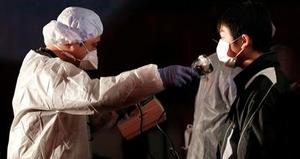DisastersNuclear countries glean lessons from Japan's disaster
Japan’s effort to contain the escalating nuclear disaster reveals a series of missteps, bad luck, and desperate improvisation; what also emerges is a country that has begun to question some of its oldest values: Japanese have long revered the country’s bureaucratic competence, especially when it is contrasted with its political dysfunction; Japan has also proudly often chosen to go its own way and turn down outside assistance; other countries relying on nuclear power generation are trying to see whether the Japanese disaster holds lessons for them

Testing for contamination // Source: bighaber.com
As a crew of about 100 Japanese workers and soldiers battled to keep a string of six nuclear reactors from meltdown just short of a week into Japan’s nuclear crisis, the arsenal of weapons at their disposal remained improvised, low-tech, and underpowered.
A police riot control truck was hauled in over uneven roads to keep a spray of water on the No. 3 and No. 4 reactors. In the air above, Japan Self-Defense Forces helicopters made runs with baskets of water in a desperate attempt to cool exposed fuel rods believed to have already partly melted down.
Meanwhile, technicians were dashing to complete what amounts to the world’s largest extension cord: an electric cable to connect the stricken plant from the north and allow Tokyo Electric Power Company (TEPCO), which runs the plant, to restart critical water pumps taken out by the massive earthquake and tsunami that hit Japan on the afternoon of Friday 11 March.
An examination by Reuters of Japan’s effort to contain its escalating nuclear disaster reveals a series of missteps, bad luck, and desperate improvisation. What also emerges is a country that has begun to question some of its oldest values. Japanese have long revered the country’s bureaucratic competence, especially when it is contrasted with its political dysfunction. Japan has also proudly often chosen to go its own way and turn down outside assistance. What happens when competence begins to break down? What happens when a disaster is so overwhelming that outside help is vital?
The Fukushima plant was designed to withstand a violent earthquake, but the massive tsunami that followed knocked out both the plant’s electric-powered cooling system and its diesel-powered backup generators.
As the first pictures of the destruction around the northern town of Sendai were beamed across Japan and around the world in the hours after the quake, authorities initially said they had safely shut down the four nuclear plants closest to the earthquake and tsunami zone.
It was not true. With no power to the plant’s cooling system, the water that circulates around the fuel rods inside the six reactors at Fukushima had already begun to boil off. Within a few hours authorities declared a “nuclear emergency situation” at the plant. While no radiation release had been detected, they said, residents around the plant should evacuate.
It was the beginning of a new nightmare. Over the ensuing days, as Japan has struggled to come to terms with what
